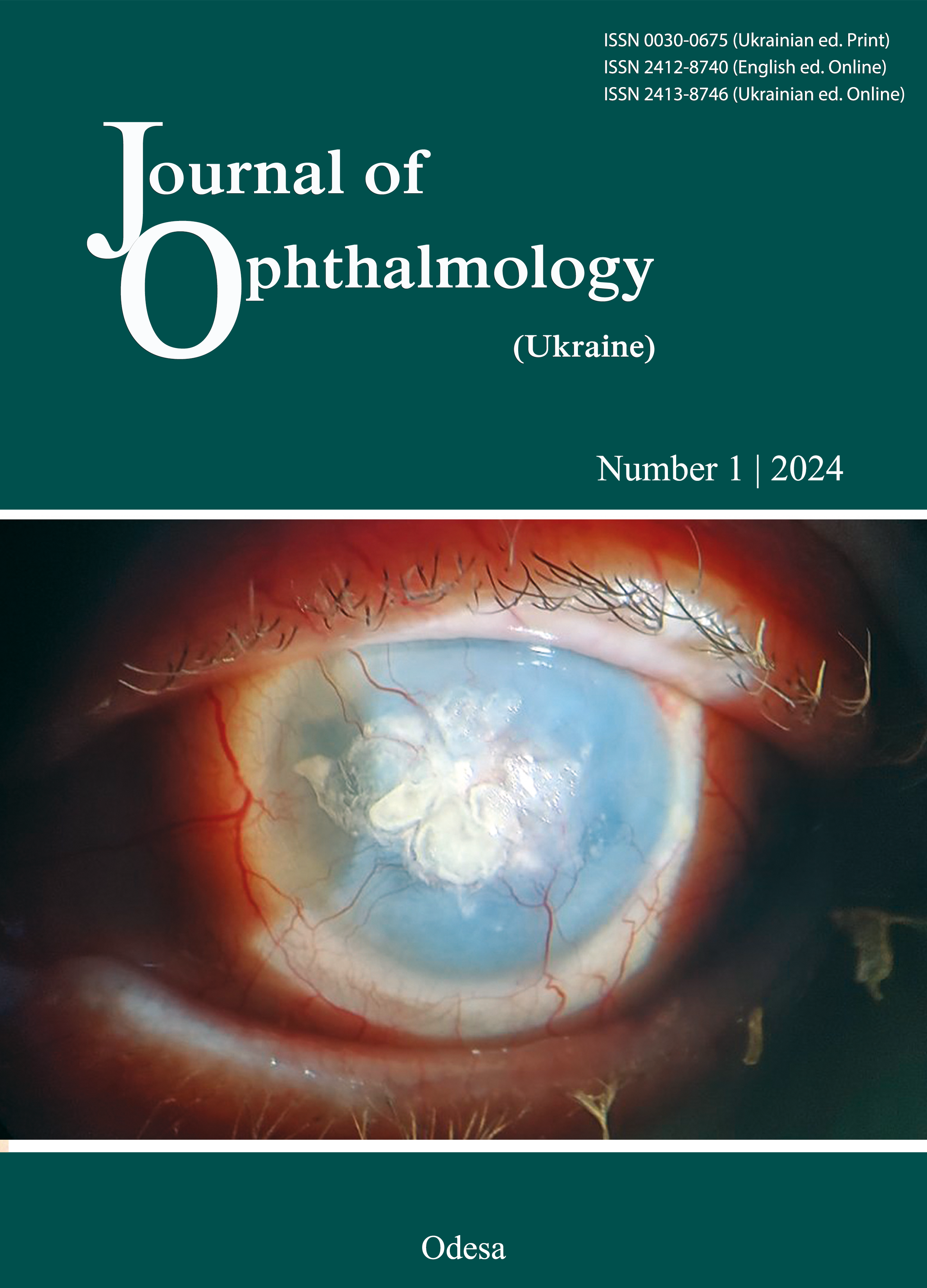Effects of vitreous angiopoietin-2 levels in rhegmatogenous retinal detachment on the macular microvascular bed
DOI:
https://doi.org/10.31288/oftalmolzh202413236Keywords:
angiopoietin-2, rhegmatogenous retinal detachment, OCT angiography, maculaAbstract
Background: Our previous optical coherent tomography angiography (OCTA) study of rhegmatogenous retinal detachment (RRD) treatment has found an impaired retinal microvascular bed over a 12-month postoperative follow-up and warranted for the study of vitreous angiopoietin (Ang)-2 levels as a vascular destabilizing factor in patients treated for RRD.
Purpose: To assess vitreous Ang-2 levels in patients with primary RRD and their association with OCTA-based changes in the macular microvascular bed in patients with RRD.
Material and Methods: Eighty-seven patients with primary RRD were involved in the study and divided into two groups depending of the state of the macula: patients that underwent surgery for macular-on RRD (group 1) and those that underwent surgery for macular-off RRD (group 2). All patients had their vitreous samples taken and underwent subtotal posterior vitrectomy. Concentrations of Ang-2 in these samples were measured by an enzyme-linked immunosorbent assay (ELISA) kit (Human Angiopoietin-2 ELISA Kit, Thermo Fisher SCIENTIFIC, Rockford, IL, USA) in accordance with the manufacturer’s protocol. We assessed correlations of vitreous Ang-2 levels and OCTA-based parameters in patients.
Results: At the preoperative vitreous Ang-2 level of 129.7 ± 51.99 pg/ml in group 1, there was a strong correlation of preoperative OCTA-based foveal avascular zone (FAZ) area, parafoveal deep capillary plexus density (PDCPD) and foveal deep capillary plexus density (FDCPD) with vitreous Ang-2 levels over the study period for group 1. At the preoperative vitreous Ang-2 level of 693.8 ± 634.7 pg/ml in group 2, there was a strong correlation of OCTA-based FAZ area, FDCPD, and PDCPD with vitreous Ang-2 levels at baseline and 12 months, and a moderate direct correlation of OCTA-based FAZ area, FDCPD, and PDCPD with vitreous Ang-2 levels at months 3 and 6.
Conclusion: Vitreous Ang-2 levels were significantly lower in macula-on RRD eyes than in macula-off RRD eyes (129.7 ± 51.99 pg/ml versus 693.8 ± 634.7 pg/ml, p < 0.001). There was a strong direct correlation (p < 0.05) of Ang-2 with OCTA-based characteristics of the retinal microvascular bed (FAZ area, PDCPD and FDCPD) for both groups, which indirectly indicates the effect of the vascular destabilizing factor on the postoperative best-corrected visual acuity.
References
Kuhn F, Aylward B. Rhegmatogenous retinal detachment: a reappraisal of its pathophysiology and treatment. Ophthalmic Res. 2014; 51(1):15-31. https://doi.org/10.1159/000355077
Bezkorovaina I, Ivanchenko A. Correlation between optical coherence tomography angiography-based data and postoperative visual acuity in patients that underwent surgery for macula-on RRD and macula-off RRD. J of Ophthalmology (Ukraine). 2023; 3 (512): 42-48. https://doi.org/10.31288/oftalmolzh202334248
Teresa T, Sandra K. Anti-inflammatory cytokine and angiogenic factors levels in vitreous samples of diabetic retinopathy patients. PLoSOne. 2018; 13(3):36-49. https://doi.org/10.1371/journal.pone.0194603
Antonia M, Federico R. Angiopoietin/Tie2 signaling and its role in retinal and choroidal vascular diseases: a review of preclinical data. Eye (Lond). 2021; 35(5): 1305-16. https://doi.org/10.1038/s41433-020-01377-x
Jaeryung K, Jang R. Tie2 activation promotes choriocapillary regeneration for alleviating neovascular age-related macular degeneration. Science Advance. 2019;5( 2):23-39. https://doi.org/10.1126/sciadv.aau6732
Bezkorovayna IM, Steblovska IS, Ryadnova VV, Pera-vasilchenko AV, Voskresenska LK, Bezega NM. Prediction of the development of retinal morphological changes after phacoemulsification based on the state of the cytokine profile of intraocular fluid. Wiadomoṥci Lekarskie. 2020; LXXIIІ (4):792-5. https://doi.org/10.36740/WLek202004133
Borrelli E, Sarraf D. OCT angiography and evaluation of the choroid and choroidal vascular disorders. Prog Retin Eye Res. 2018;67:30-55. https://doi.org/10.1016/j.preteyeres.2018.07.002
Savchenko LG, Digtiar NI, Selikhova LG, Vesnina LE., Kaidashev IP. Liraglutide exerts an anti-inflammatory action in obese patients with type 2 diabetes. Romanian journal of internal medicine = Revue roumaine de medecine interne. 2019;57(3):233-40. https://doi.org/10.2478/rjim-2019-0003
Chekalina NI, Shut SV, Trybrat TA, Manusha YI, Kazakov YM. Effect of quercetin on parameters of central hemodynamics and myocardial ischemia in patients with stable coronary heart disease. Wiadomosci lekarskie.2017;70(4):707-11.
Thiago C, Luiz G. Retinal and choroidal angiogenesis: a review of new targets. Cabral et al. Int J RetinVitr. 2017;3(31): 51-64. https://doi.org/10.1186/s40942-017-0084-9
Chen S, Zhou Y. Anti-neovascularization effects of DMBT in age-related macular degeneration by inhibition of VEGF secretion through ROS-dependent signaling pathway. Mol Cell Biochem. 2018;448:225-35. https://doi.org/10.1007/s11010-018-3328-6
Majid K, Aamir A. Targeting Angiopoietin in Retinal Vascular Diseases: A Literature Review and Summary of Clinical Trials Involving Faricimab Cells. 2020; 9(8):174-86. https://doi.org/10.3390/cells9081869
Downloads
Published
How to Cite
Issue
Section
License
Copyright (c) 2024 Bezkorovaina I. M., Ivanchenko A. Iu.

This work is licensed under a Creative Commons Attribution 4.0 International License.
This work is licensed under a Creative Commons Attribution 4.0 International (CC BY 4.0) that allows users to read, download, copy, distribute, print, search, or link to the full texts of the articles, or use them for any other lawful purpose, without asking prior permission from the publisher or the author as long as they cite the source.
COPYRIGHT NOTICE
Authors who publish in this journal agree to the following terms:
- Authors hold copyright immediately after publication of their works and retain publishing rights without any restrictions.
- The copyright commencement date complies the publication date of the issue, where the article is included in.
DEPOSIT POLICY
- Authors are permitted and encouraged to post their work online (e.g., in institutional repositories or on their website) during the editorial process, as it can lead to productive exchanges, as well as earlier and greater citation of published work.
- Authors are able to enter into separate, additional contractual arrangements for the non-exclusive distribution of the journal's published version of the work with an acknowledgement of its initial publication in this journal.
- Post-print (post-refereeing manuscript version) and publisher's PDF-version self-archiving is allowed.
- Archiving the pre-print (pre-refereeing manuscript version) not allowed.












